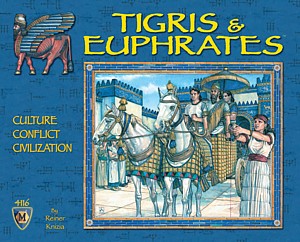1997 and 1998 Gave Us Some Great Games
Earlier I presented you with this list of board games from the late 1990s.
| The Settlers of Catan | 1995 |
| El Grande | 1995 |
| Hannibal: Rome vs. Carthage | 1996 |
| Tigris & Euphrates | 1997 |
| Samurai | 1998 |
| Ra | 1999 |
| Tikal | 1999 |
| Roads and Boats | 1999 |
| Union Pacific | 1999 |
| Paths of Glory | 1999 |
I’m not very familiar with the game from 1996, Hannibal: Rome vs. Carthage, so I don’t feel confident in telling you much about it here other than to say it’s still a popular war game.
I will tell you about both Tigris & Euphrates and Samurai though from 1997 and 1998. Tigris & Euphrates (T&E, for short) is currently the oldest board game in the top 10 favorites found at BoardGameGeek.com. Samurai is a bit farther down at number 52.
Tigris & Euphrates

T&E was created by Reiner Knizia, a master game craftsman, and it is considered by many to be his best game ever, his masterpiece. Subsequent to its original publication in 1997, other companies have developed versions with a double-sided board and advanced rules.
Since I don’t own one of those versions and have only played with the original rules, I can’t comment on them here. I only mention these things so that you are aware of them should you consider purchasing the game.
T&E is a tile-laying board game for 2-4 players. Many consider the 4-player version to be the best but the 2- and 3-player versions are far from bad. I personally have usually played the 3-player game. I may have played a 4-player game, but I have not played a 2-player game.
The tiles in T&E come in four colors: Red are the Temple tiles; blue are Farm; green are Market; and Black are Settlement. Combine those with the four leaders (disks) that each player uses: The red disk standing for Religion; the blue for Farming; the green for Trading; and the black for Government.
You can probably guess just from the descriptions of these basic bits that this is a fun board game about building a civilization. However, if you don’t care for that theme, don’t worry. This is a Eurogame where theme doesn’t matter much. Once you’re into the game, it’s really just the colors, not what they represent, that matter.
Through clever placement and replacement of your leaders and the tiles, you attempt to build tile clusters on the game board that can attack and defeat other clusters of the same color. If you are successful, you score points which are tracked by matching cubes (red, blue, green, black) that are kept hidden behind your cardboard shield.
There are several other game features and rule details that I won’t delve into here but that make this a very interesting and fun board game.
As is often the case in a Knizia creation, final scoring rewards those who have not become overly specialized in one color. Your final score is the number of cubes you collected in your weakest color, the color of which you have the fewest. So spread the wealth around throughout the game, and you’ll likely win this fun board game.
Samurai

Another fun board game by Reiner Knizia is Samurai. This game also involves tiles, but it has a very different feel from T&E.
Samurai is played on a board that is the map of medieval Japan. You’ll see the city of Edo, for example, instead of modern-day Tokyo.
The number of players (2-4, with 3 probably being the best) determines how much of the map is used. The board comes in four pieces which are put together like a jigsaw puzzle. If only two people are playing, you just use the two boards that lock together to form the main island of Honshu. If three play, add the section for Hokkaido in the north. And if four play, add the final, southern section showing Kyushu and Shikoku.
Besides the board and tiles, this game comes with beautiful, shiny, black pieces called High Helmets, Buddhas, and Rice Paddies. These bits start on the cities on the map.
Your task is to surround them with your (mostly) numbered tiles and to have the highest total around the city when the “assault” on it is complete. If the city contains a High Helmet, for example, and you have the most valuable High Helmet tiles adjacent to it, you claim that High Helmet, placing it behind your shield. Some cities have more than one black bit on them. When such a city is surrounded, each bit is awarded to the appropriate player.
Your goal is to have more black bits than anyone else of (at least) one of the three types, and then to have the most remaining bits of the other types. (Remember, this is a Knizia game, so you can’t count on traditional scoring methods.)
There are tiles that have other uses which add a good deal of the flavor to this fun board game. Altogether there are 20 tiles in each color, but you only get to choose from 5 of them to play at any one time. The remainder are kept face down as a random draw pile to replenish your face-up stock.
Winning this board game requires knowing when to play and when not to play a certain tile next to a city. You don’t want someone else to take advantage of you at the last minute and “pull the rug out from under you” claiming that shiny little Rice Paddy as his own.
